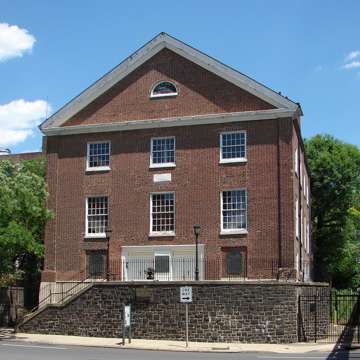Begun by the German Reformed congregation as the Georg Kirche, the shell of the church was purchased by Methodists to serve converts to their new denomination. Its location on the edge of the city in the working-class neighborhoods foretold the future of the denomination. The spartan brick facade with a simple cornice, like that of the nearby Quaker meetinghouse (PH6), contrasted with the worldly sophistication of the Church of England from which they had splintered as a reform movement in the mid-eighteenth century. In another of the legalistic definitions in which Philadelphians specialize, its members claim it to be the “oldest, continuously used” Methodist church in the world. In this church the Reverend Richard Allen became the first African American Methodist licensed to preach. Allen later founded the African Methodist Church, and formed the congregation of “Mother Bethel” (PH37). The church has been improved, beginning with galleries in the 1790s and the insertion of a basement for its Sunday school in 1835. It narrowly escaped demolition in 1921 when it was projected as part of the site of the Delaware River Bridge (PH1). A fourteen-foot shift of the bridge route spared it.
You are here
St. George's Methodist Episcopal Church
If SAH Archipedia has been useful to you, please consider supporting it.
SAH Archipedia tells the story of the United States through its buildings, landscapes, and cities. This freely available resource empowers the public with authoritative knowledge that deepens their understanding and appreciation of the built environment. But the Society of Architectural Historians, which created SAH Archipedia with University of Virginia Press, needs your support to maintain the high-caliber research, writing, photography, cartography, editing, design, and programming that make SAH Archipedia a trusted online resource available to all who value the history of place, heritage tourism, and learning.















